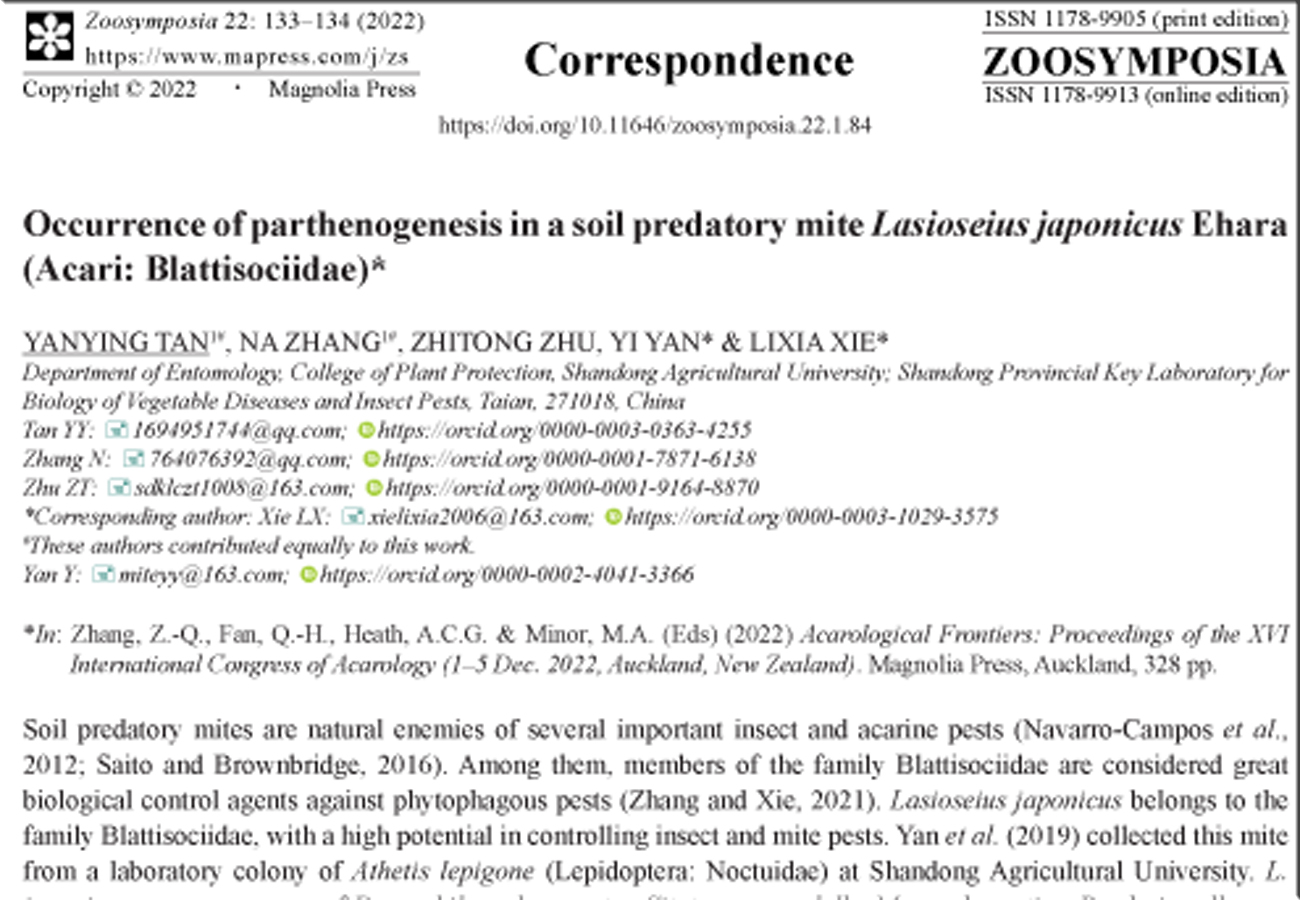Abstract
Soil predatory mites are natural enemies of several important insect and acarine pests (Navarro-Campos et al., 2012; Saito and Brownbridge, 2016). Among them, members of the family Blattisociidae are considered great biological control agents against phytophagous pests (Zhang and Xie, 2021). Lasioseius japonicus belongs to the family Blattisociidae, with a high potential in controlling insect and mite pests. Yan et al. (2019) collected this mite from a laboratory colony of Athetis lepigone (Lepidoptera: Noctuidae) at Shandong Agricultural University. L. japonicus can prey on eggs of Drosophila melanogaster, Sitotroga cerealella, Musca domestica, Bradysia cellarum, Tyrophagus putrescentiae, and larvae of B. cellarum and T. putrescentiae (Li, 2019; Zhang et al., 2020).
References
Li, Y.Y. (2019) Evaluation effect on Bradysia odoriphaga and optimization of feeding prey of Lasioseius japonicas. Shandong Agricultural University, Taian, China, 20 pp.
Navarro-Campos, C., Pekas, A., Moraza, M.L., Aguilar, A. & Garcia-Marí, F. (2012) Soil-dwelling predatory mites in citrus: their potential as natural enemies of thrips with special reference to Pezothrips kellyanus (Thysanoptera: Thripidae). Biological Control, 63 (2), 201–209. https://doi.org/10.1016/j.biocontrol.2012.07.007
Oliver, J.H. (1971) Parthenogenesis in mites and ticks (Arachnida-Acari). American Zoologist, 11 (2), 283.
Saito, T. & Brownbridge, M. (2016) Compatibility of soil-dwelling predators and microbial agents and their efficacy in controlling soil-dwelling stages of western flower thrips Frankliniella occidentalis. Biological Control: Theory and Application in Pest Management, 92, 92–100. https://doi.org/10.1016/j.biocontrol.2015.10.003
Wright, E.M. & Chambers, R.J. (1994) The biology of the predatory mite Hypoaspis miles (Acari: Laelapidae), a potential biological control agent of Bradysia paupera (Dipt: Sciaridae). Entomophaga, 39 (2), 225–235. https://doi.org/10.1007/BF02372360
Yan, Y., Zhang, Q., Zhou, C.Y. & Xie, L.X. (2019) Notes on soil predatory mites: the genus Lasioseius with a newly recorded species and key from China (Acari: Mesostigmata: Blattisociidae). Entomotaxonomia, 41 (1), 44–53. https://doi.org/10.11680/entomotax.2019006
Zhang, N., Xie, L.X., Wu, X.R., Liu, K., Liu, C.L. & Yan, Y. (2020) Development, survival and reproduction of a potential biological control agent, Lasioseius japonicus Ehara (Acari: Blattisociidae), on eggs of Drosophila melanogaster (Diptera: Drosophilidae) and Sitotroga cerealella (Lepidoptera: Gelechiidae). Systematic and Applied Acarology, 25 (8), 1461–1471. https://doi.org/10.11158/saa.25.8.8
Zhang, N. & Xie, L.X. (2021) The lifespans of the potential biological control agents in the family Blattisociidae (Acari: Mesostigmata). Zoosymposia, 20, 91–103. https://doi.org/10.11646/zoosymposia.20.1.10


